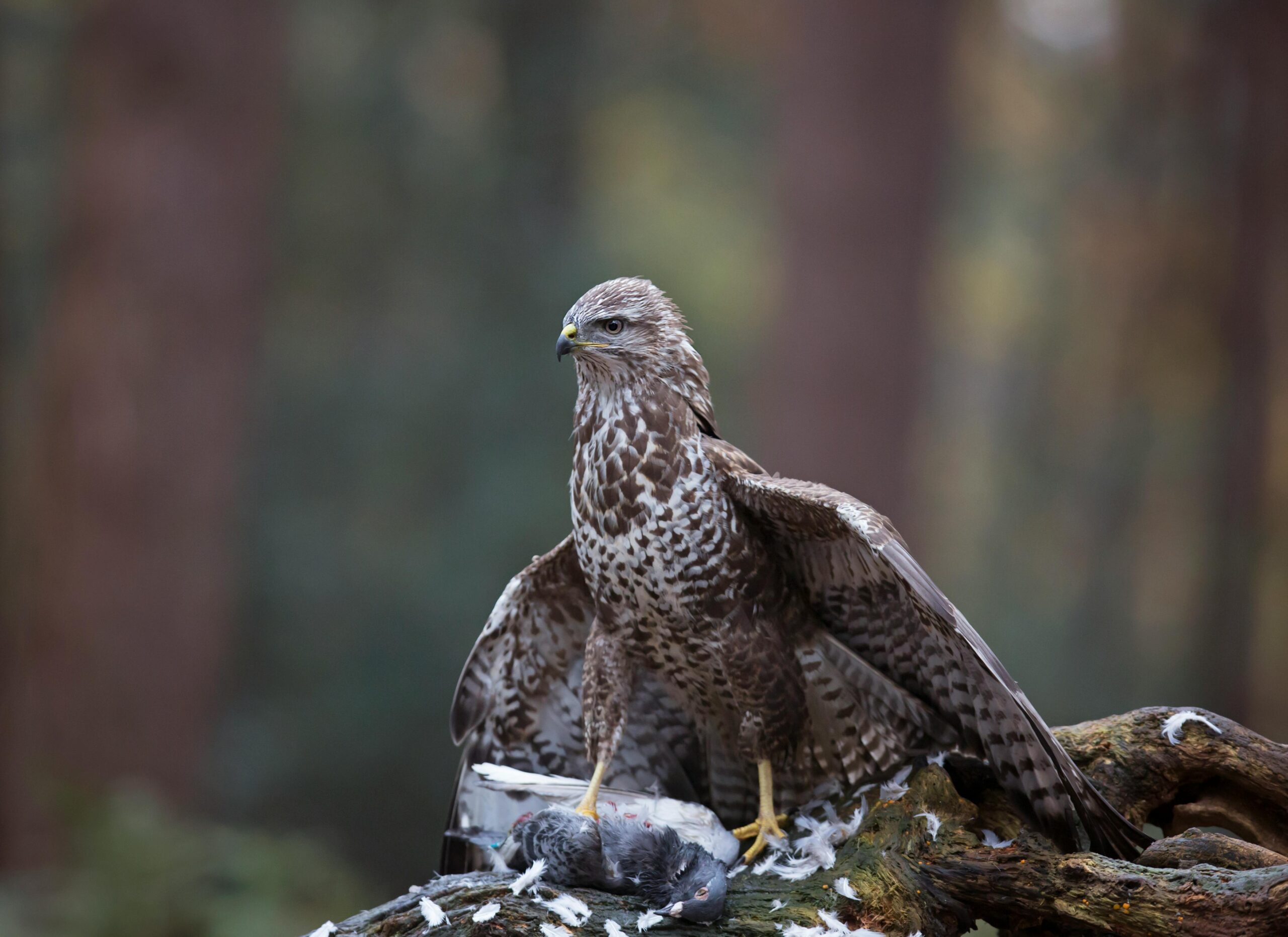The common buzzard (Buteo buteo) is a highly adaptable bird of prey found across Europe and parts of Asia. As an opportunistic hunter, its diet varies based on habitat, season, and food availability. While small mammals form a significant part of its meals, buzzards are also known to consume birds, reptiles, amphibians, and even carrion. Their ability to switch between hunting live prey and scavenging makes them one of the most versatile raptors in their ecosystem. This article explores the diverse diet of common buzzards, examining their feeding habits, hunting techniques, and how their environment influences what they eat.
Primary Diet of Common Buzzards
Common buzzards primarily feed on small mammals, making them a crucial part of their diet. These raptors prefer prey that is abundant and easy to catch, allowing them to conserve energy while hunting. Rodents such as voles, mice, and rats are among their most common meals. In open landscapes like farmlands and grasslands, these mammals provide a steady food source, particularly in warmer months when their populations are at their peak.
During hunting, common buzzards rely on their keen eyesight to detect movement from a distance. They often soar high in the sky or perch on trees, poles, or fences, patiently scanning the ground for potential prey. Once they spot a target, they dive swiftly, using their sharp talons to capture and immobilize it.
Although small mammals dominate their diet, common buzzards can adjust their feeding habits based on prey availability. When rodents become scarce, they turn to alternative food sources, ensuring their survival even in challenging conditions.
Small Mammals as a Staple Food
Small mammals are not only a primary food source but also an essential part of the buzzard’s role in the ecosystem. By controlling rodent populations, these raptors help maintain a natural balance, preventing overpopulation of small prey species.
Buzzards typically consume their prey whole or tear it into smaller pieces using their strong, hooked beaks. The bones and fur of rodents provide additional nutrients, contributing to their overall health.
The preference for small mammals also varies by region and season:
- In wooded areas, buzzards may hunt more shrews and voles, as these species thrive in dense vegetation.
- In farmlands, they often prey on field mice and young rabbits, taking advantage of open fields for easier hunting.
- During winter months, when live prey is less available, they might scavenge carrion or consume alternative prey like birds and reptiles.
Their dietary flexibility makes them one of the most resilient raptors, capable of surviving in diverse environments.
Birds and Their Role in the Buzzard’s Diet
Although small mammals are the primary food source for common buzzards, birds also make up a significant part of their diet, particularly when rodents are scarce. Buzzards are not as specialized in hunting birds as other raptors like falcons, but they will prey on them when the opportunity arises. Their avian prey includes pigeons, crows, starlings, and small game birds such as pheasants and partridges.
Buzzards usually target weaker, slower, or injured birds, as their hunting techniques rely more on ambush and surprise rather than high-speed chases. Nestlings and fledglings are also vulnerable, especially during the breeding season when young birds are abundant.
Scavenging is another way buzzards consume birds. They frequently feed on roadkill or the remains of birds that have fallen victim to other predators. This behavior helps them conserve energy, especially during winter months when live prey is harder to catch.
Hunting Techniques for Capturing Birds
Since buzzards are not built for aerial pursuits, they use a combination of different strategies to catch birds. These include:
- Perch Hunting: Buzzards wait on tree branches or fence posts, scanning the ground and air for unsuspecting birds. When an opportunity arises, they swoop down quickly to grab their prey.
- Ground Ambush: In open fields, buzzards might stalk birds on the ground, relying on stealth and sudden bursts of speed. This is particularly effective for capturing ground-feeding birds like larks or thrushes.
- Opportunistic Hunting: They may take advantage of disturbed flocks, catching birds that are startled and attempting to escape. For example, in agricultural areas, they sometimes hunt near tractors that flush birds out of the fields.
Despite their ability to hunt birds, common buzzards prefer easier prey like rodents. Their broad wings and soaring flight make them better suited for scanning landscapes rather than chasing fast-moving birds. However, when necessary, they can effectively adapt their hunting techniques to target avian prey.
Reptiles, Amphibians, and Invertebrates in Their Diet
While small mammals and birds form the bulk of a common buzzard’s diet, they also consume reptiles, amphibians, and invertebrates, especially when other food sources are scarce. This dietary adaptability allows them to thrive in various habitats, from forests to farmland and even urban areas.
Reptiles such as lizards and snakes are commonly eaten, particularly in warmer regions where these species are abundant. Amphibians like frogs and toads also become an important food source, especially during the rainy season when they emerge in large numbers.
Invertebrates, including earthworms, beetles, and grasshoppers, serve as supplemental food, particularly for juvenile buzzards learning to hunt. During wet weather, buzzards can often be seen foraging on the ground, picking up worms from the soil.
Although these prey types are not the primary focus of their diet, they play a crucial role in the buzzard’s ability to survive in varying environmental conditions.
Seasonal Availability of Alternative Prey
The availability of reptiles, amphibians, and invertebrates depends largely on the season and habitat. Common buzzards adjust their feeding habits based on what is accessible at different times of the year:
- Spring and Summer: Warm temperatures lead to an increase in lizards, snakes, frogs, and insects. Buzzards take advantage of this abundance, often hunting in open fields and near water sources.
- Autumn: As temperatures drop, many reptiles and amphibians enter hibernation, reducing their availability as food. Buzzards shift their focus back to small mammals and birds.
- Winter: With cold weather limiting the presence of reptiles and amphibians, buzzards rely more on scavenging carrion and catching whatever small prey they can find. They may also target larger insects, such as beetles, if conditions allow.
This seasonal adaptability makes the common buzzard a highly resilient predator, capable of surviving in changing environments and maintaining its role in the food chain.
Scavenging Behavior of Common Buzzards
In addition to hunting live prey, common buzzards are known for their scavenging behavior. This opportunistic feeding strategy allows them to conserve energy by feeding on carrion rather than actively hunting. Buzzards often consume the remains of dead animals, including roadkill, livestock carcasses, and other scavenged meat.
Scavenging plays an essential role in the ecosystem, as it helps prevent the spread of disease by accelerating the decomposition process. While some raptors, such as vultures, are specialized scavengers, buzzards combine both hunting and scavenging to maximize their food intake.
Buzzards are often seen near roadsides, where they take advantage of animals killed by vehicles. In rural areas, they may also feed on deceased livestock or carcasses left behind by other predators.
How They Compete with Other Scavengers
Since scavenged food is a valuable resource, competition among scavengers is common. Buzzards must often compete with other birds of prey, mammals, and corvids (such as crows and ravens) for access to carrion. The outcome of these interactions depends on factors such as size, dominance, and aggression.
- Against Corvids (Crows & Ravens): Although buzzards are larger, crows and ravens are highly intelligent and often mob buzzards to drive them away from a carcass. Buzzards sometimes wait for corvids to leave before feeding.
- Against Other Raptors: Buzzards occasionally face competition from red kites and larger eagles, which can force them to abandon their scavenged meals.
- Against Mammals: Foxes, badgers, and other carnivorous mammals may also challenge buzzards for carrion. When faced with a larger competitor, buzzards will often yield and search for food elsewhere.
Despite these challenges, scavenging remains an important survival strategy, especially during winter months when live prey is less abundant. By balancing hunting and scavenging, common buzzards demonstrate their ability to adapt and thrive in various environments.
Impact of Habitat on Buzzard Feeding Habits
The diet of common buzzards is heavily influenced by their habitat, as different environments provide varying food sources. Buzzards are highly adaptable raptors, capable of adjusting their feeding habits based on prey availability, human activity, and seasonal changes.
In woodlands and forests, their diet consists mainly of small mammals, such as voles and mice, which thrive in dense vegetation. In open farmland and grasslands, they hunt rabbits, hares, and ground-feeding birds. Meanwhile, in coastal regions, they may consume small seabirds, fish, or even crustaceans.
Urban and suburban areas present a unique challenge for buzzards, but some individuals have successfully adapted to living near human settlements by scavenging from roadsides and hunting in parks or gardens.
Differences in Rural and Urban Diets
Buzzards in rural and urban environments exhibit distinct differences in their feeding habits:
- Rural Buzzards:
- Rely more on natural prey such as rodents, birds, and reptiles.
- More likely to hunt live animals rather than scavenge.
- Face fewer disturbances from humans but compete with other predators.
- Urban Buzzards:
- More likely to scavenge roadkill and food waste.
- May hunt pigeons, rats, and smaller birds commonly found in cities.
- Adapt to human presence but face risks such as traffic and habitat destruction.
Buzzards are highly opportunistic feeders, allowing them to survive in diverse environments. Their ability to modify their diet based on habitat ensures their success as one of Europe’s most widespread birds of prey.
Conclusion
The common buzzard (Buteo buteo) is a highly adaptable raptor with a diverse diet that varies based on habitat, season, and prey availability. While small mammals, such as voles and rabbits, form the core of their diet, they also consume birds, reptiles, amphibians, and invertebrates when the opportunity arises. Additionally, their ability to scavenge carrion allows them to survive during harsh conditions, particularly in winter.
Buzzards use a variety of hunting techniques, including perch-hunting, ground ambush, and opportunistic scavenging. Their habitat plays a significant role in shaping their diet, with rural buzzards relying more on natural prey, while urban buzzards adapt to scavenging and hunting city-dwelling species.
By balancing predation and scavenging, common buzzards maintain their role as essential predators in the ecosystem. Their dietary flexibility ensures their survival in diverse environments, making them one of the most widespread and successful birds of prey in Europe.

